Finite Difference Methods for PDEs
Per-Olof Persson
persson@berkeley.edu
Math 228B Numerical Solutions of Differential Equations
Finite Difference Approximations
Finite Difference Approximations
\[\begin{aligned} D_+ u(\bar{x}) &= \frac{u(\bar{x}+h)-u(\bar{x})}{h} = u'(\bar{x})+\frac{h}{2} u''(\bar{x}) + \mathcal{O}(h^2) \\ D_- u(\bar{x}) &= \frac{u(\bar{x})-u(\bar{x}-h)}{h} = u'(\bar{x})-\frac{h}{2} u''(\bar{x}) + \mathcal{O}(h^2) \\ D_0 u(\bar{x}) &= \frac{u(\bar{x}+h)-u(\bar{x}-h)}{2h} = u'(\bar{x})+\frac{h^2}{6} u'''(\bar{x}) + \mathcal{O}(h^4) \\ D^2 u(\bar{x}) &= \frac{u(\bar{x}-h)-2u(\bar{x})+u(\bar{x}+h)}{h^2} \\ &= u''(\bar{x}) + \frac{h^2}{12}u''''(\bar{x})+\mathcal{O}(h^4) \end{aligned}\]
Method of Undetermined Coefficients
Find approximation to \(u^{(k)}(\bar{x})\) based on \(u(x)\) at \(x_1,x_2,\ldots,x_n\)
Write \(u(x_i)\) as Taylor series centered at \(\bar{x}\): \[\begin{aligned} u(x_i) &= u(\bar{x}) + (x_i-\bar{x})u'(\bar{x}) + \cdots + \frac{1}{k!} (x_i-\bar{x})^k u^{(k)}(\bar{x}) + \cdots \end{aligned}\]
Seek approximation of the form \[\begin{aligned} u^{(k)}(\bar{x}) = c_1 u(x_1) + c_2 u(x_2) + \cdots + c_n u(x_n) + \mathcal{O}(h^p) \end{aligned}\]
Collect terms multiplying \(u(\bar{x})\), \(u'(\bar{x})\), etc, to obtain: \[\begin{aligned} \frac{1}{(i-1)!} \sum_{j=1}^n c_j (x_j-\bar{x})^{(i-1)} = \begin{cases} 1 & \text{if } i-1=k \\ 0 & \text{otherwise.} \end{cases} \end{aligned}\]
Nonsingular Vandermonde system if \(x_j\) are distinct
Finite difference stencils, Julia implementation
"""
c = mkfdstencil(x, xbar, k)
Compute the coefficients `c` in a finite difference approximation of a function
defined at the grid points `x`, evaluated at `xbar`, of order `k`.
"""
function mkfdstencil(x, xbar, k)
n = length(x)
A = @. (x[:]' - xbar) ^ (0:n-1) / factorial(0:n-1)
b = (1:n) .== k+1
c = A \ b
endExamples:
julia> println(mkfdstencil([-1 0 1], 0, 2)) # Centered 2nd derivative
[1.0, -2.0, 1.0]
julia> println(mkfdstencil([0 1 2], 0, 1)) # One-sided (right) 1st derivative
[-1.5, 2.0, -0.5]
julia> println(mkfdstencil(-2:2, 0//1, 2)) # 4th order 5-point stencil, rational
Rational{Int64}[-1//12, 4//3, -5//2, 4//3, -1//12]Boundary Value Problems
The Finite Difference Method
Consider the Poisson equation with Dirichlet conditions: \[\begin{aligned} u''(x) = f(x),\quad 0<x<1,\quad u(0)=\alpha,\quad u(1)=\beta \end{aligned}\]
Introduce \(n\) uniformly spaced grid points \(x_j=jh\), \(h=1/(n+1)\)
Set \(u_0=\alpha\), \(u_{n+1}=\beta\), and use the three-point difference approximation to get the discretization \[\begin{aligned} \frac{1}{h^2} (u_{j-1} - 2u_j + u_{j+1}) = f(x_j),\quad j=1,\ldots,n \end{aligned}\]
This can be written as a linear system \(Au=f\) with
\[\begin{aligned} A=\frac{1}{h^2} \begin{bmatrix} -2 & 1 & & \\ 1 & -2 & 1 & \\ & & \ddots & \\ & & 1 & -2 \end{bmatrix} \quad u= \begin{bmatrix} u_1 \\ u_2 \\ \vdots \\ u_n \end{bmatrix} \quad f= \begin{bmatrix} f(x_1) - \alpha/h^2 \\ f(x_2) \\ \vdots \\ f(x_n)-\beta/h^2 \end{bmatrix} \end{aligned}\]
Errors and Grid Function Norms
The error \(e=u-\hat{u}\) where \(u\) is the numerical solution and \(\hat{u}\) is the exact solution \[\begin{aligned} \hat{u} = \begin{bmatrix} u(x_1) \\ \vdots \\ u(x_n) \end{bmatrix} \end{aligned}\]
Measure errors in grid function norms, which are approximations of integrals and scale correctly as \(n\rightarrow\infty\) \[\begin{aligned} \|e\|_\infty &= \max_j |e_j| \\ \|e\|_1 &= h \sum_j |e_j| \\ \|e\|_2 &= \left( h\sum_j |e_j|^2 \right)^{1/2} \end{aligned}\]
Local Truncation Error
Insert the exact solution \(u(x)\) into the difference scheme to get the local truncation error: \[\begin{aligned} \tau_j &= \frac{1}{h^2} (u(x_{j-1}) - 2u(x_j) + u(x_{j+1})) - f(x_j) \\ &= u''(x_j) + \frac{h^2}{12} u''''(x_j) + \mathcal{O}(h^4) - f(x_j) \\ &= \frac{h^2}{12} u''''(x_j) + \mathcal{O}(h^4) \end{aligned}\] or \[\begin{aligned} \tau=\begin{bmatrix} \tau_1 \\ \vdots \\ \tau_n \end{bmatrix} = A\hat{u}-f \end{aligned}\]
Errors
Linear system gives error in terms of LTE: \[\begin{aligned} \left\{ \begin{array}{ll} Au = f \\ A\hat{u} = f+\tau \end{array} \right. \Longrightarrow Ae = -\tau \end{aligned}\]
Introduce superscript \(h\) to indicate that a problem depends on the grid spacing, and bound the norm of the error: \[\begin{aligned} A^h e^h &= -\tau^h \\ e^h &= - (A^h)^{-1} \tau^h \\ \|e^h\| &= \|(A^h)^{-1}\tau^h\| \le \|(A^h)^{-1}\|\cdot\|\tau^h\| \end{aligned}\]
If \(\|(A^h)^{-1}\|\le C\) for \(h\le h_0\), then \[\begin{aligned} \|e^h\|\le C \cdot \|\tau^h\| \rightarrow 0 \text{ if } \|\tau^h\|\rightarrow 0\text{ as }h\rightarrow 0 \end{aligned}\]
Stability, Consistency, and Convergence
A method \(A^hu^h=f^h\) is stable if \((A^h)^{-1}\) exists and \(\|(A^h)^{-1}\|\le C\) for \(h\le h_0\)
It is consistent with the DE if \(\|\tau^h\|\rightarrow 0\) as \(h\rightarrow 0\)
It is convergent if \(\|e^h\|\rightarrow 0\) as \(h\rightarrow 0\)
Consistency + Stability \(\Longrightarrow\) Convergence
since \(\|e^h\|\le \|(A^h)^{-1}\|\cdot\|\tau^h\| \le C\cdot \|\tau^h\| \rightarrow 0\). A stronger statement is
\(\mathcal{O}(h^p)\) LTE + Stability \(\Longrightarrow\) \(\mathcal{O}(h^p)\) global error
Stability in the 2-Norm
In the 2-norm, we have \[\begin{aligned} \|A\|_2 &= \rho(A) = \max_p |\lambda_p| \\ \|A^{-1}\|_2 &= \frac{1}{\min_p |\lambda_p|} \end{aligned}\]
For our model problem matrix, we have explicit expressions for the eigenvectors/eigenvalues:
\[\begin{aligned} A=\frac{1}{h^2} \begin{bmatrix} -2 & 1 & & \\ 1 & -2 & 1 & \\ & & \ddots & \\ & & 1 & -2 \end{bmatrix} \end{aligned}\]
\[\begin{aligned} u_j^p &= \sin (p\pi j h) \\ \lambda_p &= \frac{2}{h^2}(\cos(p\pi h)-1) \end{aligned}\]
The smallest eigenvalue is \[\begin{aligned} \lambda_1 = \frac{2}{h^2}(\cos(\pi h)-1) = -\pi^2 +\mathcal{O}(h^2) \Longrightarrow \text{ Stability} \end{aligned}\]
Convergence in the 2-Norm
This gives a bound on the error \[\begin{aligned} \|e^h\|_2 \le \|(A^h)^{-1}\|_2\cdot\|\tau^h\|_2 \approx \frac{1}{\pi^2}\|\tau^h\|_2 \end{aligned}\]
Since \(\tau_j^h\approx \frac{h^2}{12} u''''(x_j)\), \[\begin{aligned} \|\tau^h\|_2 \approx \frac{h^2}{12} \|u''''\|_2 = \frac{h^2}{12}\|f''\|_2 \Longrightarrow \|e^h\|_2 = \mathcal{O}(h^2) \end{aligned}\]
While this implies convergence in the max-norm, 1/2 order is lost because of the grid function norm: \[\begin{aligned} \|e^h\|_\infty \le \frac{1}{\sqrt{h}} \|e^h\|_2 = \mathcal{O}(h^{3/2}) \end{aligned}\]
But it can be shown that \(\|(A^h)^{-1}\|_\infty=\mathcal{O}(1)\), which implies \(\|e^h\|_\infty = \mathcal{O}(h^2)\)
Neumann Boundary Conditions
Consider the Poisson equation with Neumann/Dirichlet conditions: \[\begin{aligned} u''(x) = f(x),\quad 0<x<1,\quad u'(0)=\sigma,\quad u(1)=\beta \end{aligned}\]
Second-order accurate one-sided difference approximation: \[\begin{aligned} \frac{1}{h}\left(-\frac32 u_0 + 2u_1 - \frac12 u_2\right) = \sigma \end{aligned}\] \[\begin{aligned} \frac{1}{h^2} \begin{bmatrix} -\frac{3h}{2} & 2h & -\frac{h}{2} & & \\ 1 & -2 & 1 & &\\ & & \ddots & &\\ & & 1 & -2 & 1 \\ & & & 0 & h^2 \end{bmatrix} \begin{bmatrix} u_0 \\ u_1 \\ \vdots \\ u_n \\ u_{n+1} \end{bmatrix} = \begin{bmatrix} \sigma \\ f(x_1) \\ \vdots \\ f(x_n) \\ \beta \end{bmatrix} \end{aligned}\] Most general approach.
Finite Difference Methods for Elliptic Problems
Elliptic Partial Differential Equations
Consider the elliptic PDE below, the Poisson equation: \[\begin{aligned} \nabla^2 u(x,y) \equiv \frac{\partial ^2 u}{\partial x^2} (x,y) + \frac{\partial ^2 u}{\partial y^2} (x,y) = f(x,y) \end{aligned}\] on the rectangular domain \[\begin{aligned} \Omega = \{ (x,y)\ |\ a<x<b, c<y<d \} \end{aligned}\] with Dirichlet boundary conditions \(u(x,y) = g(x,y)\) on the boundary \(\Gamma=\partial \Omega\) of \(\Omega\).
Introduce a two-dimensional grid by choosing integers \(n,m\) and defining step sizes \(h=(b-a)/n\) and \(k = (d-c)/m\). This gives the point coordinates (mesh points): \[\begin{aligned} x_i &= a+ih,\qquad i=0,1,\ldots,n \\ y_i &= c+jk,\qquad j=0,1,\ldots,m \end{aligned}\]
Finite Difference Discretization
Discretize each of the second derivatives using finite differences on the grid: \[\begin{aligned} &\frac{u(x_{i+1},y_j) - 2u(x_i,y_j) + u(x_{i-1},y_j)}{h^2} + \\ &\frac{u(x_{i},y_{j+1}) - 2u(x_i,y_j) + u(x_{i},y_{j-1})}{k^2} \\ & \quad = f(x_i,y_j) + \frac{h^2}{12} \frac{\partial^4 u}{\partial x^4}(x_i,y_j) + \frac{k^2}{12} \frac{\partial^4 u}{\partial y^4} (x_i,y_j) + \mathcal{O}(h^4 + k^4) \end{aligned}\] for \(i=1,2,\ldots,n-1\) and \(j=1,2,\ldots,m-1\), with boundary conditions \[\begin{aligned} u(x_0,y_j) &= g(x_0,y_j),\quad u(x_n,y_j)=g(x_n,y_j),\quad j=0,\ldots,m \\ u(x_i,y_0) &= g(x_i,y_0),\quad u(x_i,y_0)=g(x_i,y_m),\quad i=1,\ldots,n-1 \end{aligned}\]
Finite Difference Discretization
The corresponding finite-difference method for \(u_{i,j} \approx u(x_i,y_i)\) is \[\begin{aligned} &2\left[ \left(\frac{h}{k}\right)^2 + 1 \right] u_{ij} -(u_{i+1,j} + u_{i-1,j}) - \\ & \qquad \left(\frac{h}{k}\right)^2(u_{i,j+1} + u_{i,j-1}) = -h^2 f(x_i,y_j) \end{aligned}\] for \(i=1,2,\ldots,n-1\) and \(j=1,2,\ldots,m-1\), with boundary conditions \[\begin{aligned} u_{0j} &= g(x_0,y_j),\quad u_{nj}=g(x_n,y_j),\quad j=0,\ldots,m \\ u_{i0} &= g(x_i,y_0),\quad u_{im}=g(x_i,y_m),\quad i=1,\ldots,n-1 \end{aligned}\] Define \(f_{ij} = f(x_i,y_i)\) and suppose \(h=k\), to get the simple form \[\begin{aligned} u_{i+1,j} + u_{i-1,j} + u_{i,j+1} + u_{i,j-1} - 4 u_{i,j} = h^2 f_{ij} \end{aligned}\]
FDM for Poisson, Julia implementation
Convergence in the 2-Norm
For the homogeneous Dirichlet problem on the unit square, convergence in the 2-norm is shown in exactly the same way as for the corresponding BVP
Taylor expansions show that \[\begin{aligned} \tau_{ij} = \frac{1}{12} h^2 (u_{xxxx} + u_{yyyy}) + \mathcal{O}(h^4) \end{aligned}\]
It can be shown that the smallest eigenvalue of \(A^h\) is \(-2\pi^2 + \mathcal{O}(h^2)\), and the spectral radius of \((A^h)^{-1}\) is approximately \(1/2\pi^2\)
As before, this gives \(\|e^h\|_2 = \mathcal{O}(h^2)\)
Non-Rectangular Domains
Poisson in 2D non-rectangular domain
Consider the Poisson problem on the non-rectangular domain \(\Omega\) with boundary \(\Gamma = \Gamma_D \cup \Gamma_N = \partial \Omega\): \[\begin{aligned} -\nabla^2 u &= f & & \text{in }\Omega\\ u &= g & & \text{on }\Gamma_D \\ \frac{\partial u}{\partial n} &= r & & \text{on }\Gamma_N \end{aligned}\]
Consider a mapping between a rectangular reference domain \(\hat{\Omega}\) and the actual physical domain \(\Omega\)
Find an equivalent problem that can be solved in \(\hat{\Omega}\)
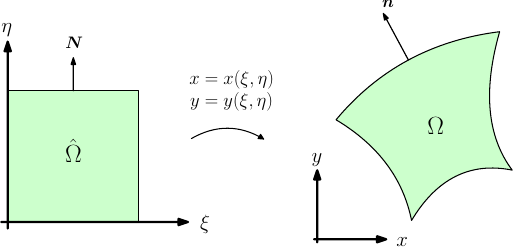
Poisson in 2D non-rectangular domainTransformed derivatives
Use the chain rule to transform the derivatives of \(u\) in the physical domain: \[\begin{aligned} u(x,y) = u(x(\xi,\eta), y(\xi,\eta))\quad\Longrightarrow\quad \begin{aligned} u_x &= \xi_x u_\xi+ \eta_x u_\eta \\ u_y &= \xi_y u_\xi+ \eta_y u_\eta \end{aligned} \end{aligned}\]
Determine the terms \(\xi_x,\eta_x,\xi_y,\eta_y\) by the mapped derivatives:
\[\begin{aligned} \xi = \xi(x,y) \\ \eta = \eta(x,y) \end{aligned}\] \[\begin{aligned} \begin{pmatrix} d\xi \\ d\eta \end{pmatrix} = \begin{pmatrix} \xi_x & \xi_y \\ \eta_x & \eta_y \end{pmatrix} \begin{pmatrix} dx \\ dy \end{pmatrix} \end{aligned}\]
\[\begin{aligned} x = x(\xi, \eta) \\ y = y(\xi, \eta) \end{aligned}\] \[\begin{aligned} \begin{pmatrix} dx \\ dy \end{pmatrix} = \begin{pmatrix} x_\xi & x_\eta \\ y_\xi & y_\eta \end{pmatrix} \begin{pmatrix} d\xi \\ d\eta \end{pmatrix} \end{aligned}\]
\[\begin{aligned} \Longrightarrow \begin{pmatrix} \xi_x & \xi_y \\ \eta_x & \eta_y \end{pmatrix} = \begin{pmatrix} x_\xi & x_\eta \\ y_\xi & y_\eta \end{pmatrix}^{-1} = \frac{1}{J} \begin{pmatrix} y_\eta & -x_\eta \\ -y_\xi & x_\xi \end{pmatrix} \end{aligned}\]
where \(J=x_\xi y_\eta - x_\eta y_\xi\)
Poisson in 2D non-rectangular domainTransformed equations
Using the derivative expressions, we can transform all the derivatives and the equation \(-(u_{xx} + u_{yy}) = f\) becomes \[\begin{aligned} -\frac{1}{J^2} (a u_{\xi\xi} -2bu_{\xi\eta} +c u_{\eta\eta} +d u_{\eta} + e u_{\xi}) = f \end{aligned}\] where \[\begin{aligned} a &= x^2_\eta + y^2_\eta & b &= x_\xi x_\eta + y_\xi y_\eta & c &=x^2_\xi + y^2_\xi \\ d &= \frac{y_\xi\alpha - x_\xi \beta}{J} & e &= \frac{x_\eta\beta - y_\eta \alpha}{J} \end{aligned}\] with \[\begin{aligned} \alpha &= a x_{\xi\xi} -2b x_{\xi\eta} + c x_{\eta\eta} \\ \beta &= a y_{\xi\xi} -2b y_{\xi\eta} + c y_{\eta\eta} \end{aligned}\]
Poisson in 2D non-rectangular domainNormal derivatives
The normal \(\boldsymbol{n}\) in the physical domain is in the direction of
\(\nabla\eta\) or \(\nabla\xi\).For example, on the top boundary \(\eta=1\) we have \[\begin{aligned} \boldsymbol{n} = (n^x, n^y) = \frac{1}{\sqrt{\eta^2_x + \eta^2_y}} (\eta_x, \eta_y) = \frac{1}{\sqrt{x^2_\xi + y^2_\xi}} (-y_\xi, x_\xi) \end{aligned}\]
This gives the normal derivative \[\begin{aligned} \hspace{-5mm} \frac{\partial u}{\partial n} = u_x n^x + u_y n^y = \frac{1}{J} \left[ (y_\eta n^x - x_\eta n^y) u_\xi + (-y_\xi n^x + x_\xi n^y) u_\eta \right] \end{aligned}\]

Finite Difference Methods for Parabolic Problems
Parabolic equations
Model problem: The heat equation: \[\begin{aligned} \frac{\partial u}{\partial t} - \nabla \cdot (\kappa \nabla u) = f \end{aligned}\] where
\(u=u(\boldsymbol{x},t)\) is the temperature at a given point and time
\(\kappa\) is the heat capacity (possibly \(\boldsymbol{x}\)- and \(t\)-dependent)
\(f\) is the source term (possibly \(\boldsymbol{x}\)- and \(t\)-dependent)
Need initial conditions at some time \(t_0\): \[\begin{aligned} u(\boldsymbol{x},t_0) = \eta(\boldsymbol{x}) \end{aligned}\]
Need boundary conditions at domain boundary \(\Gamma\):
Dirichlet condition (prescribed temperature): \(u = u_D\)
Neumann condition (prescribed heat flux): \(\boldsymbol{n}\cdot(\kappa \nabla u) = g_N\)
1D discretization
Initial case: One space dimension, \(\kappa=1\), \(f=0\): \[\begin{aligned} u_t = \kappa u_{xx}, \qquad 0\le x \le 1 \end{aligned}\] with boundary conditions \(u(0,t)=g_0(t)\), \(u(1,t)=g_1(t)\)
Introduce finite difference grid: \[\begin{aligned} x_i = ih,\quad t_n = nk \end{aligned}\] with mesh spacing \(h=\Delta x\) and time step \(k=\Delta t\).
Approximate the solution \(u\) at grid point \((x_i,t_n\)): \[\begin{aligned} U_i^n \approx u(x_i, t_n) \end{aligned}\]
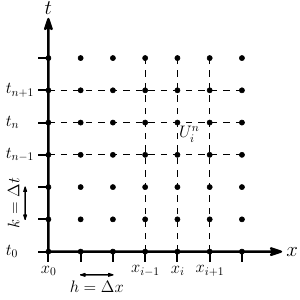
Numerical schemes: FTCS
FTCS (Forward in time, centered in space): \[\begin{aligned} \frac{U_i^{n+1} - U_i^n}{k} = \frac{1}{h^2} \left( U_{i-1}^n - 2U_i^n + U_{i+1}^n \right) \end{aligned}\] or, as an explicit expression for \(U_i^{n+1}\), \[\begin{aligned} U_i^{n+1} = U_i^n + \frac{k}{h^2} \left( U_{i-1}^n - 2U_i^n + U_{i+1}^n \right) \end{aligned}\]
Explicit one-step method in time
Boundary conditions naturally implemented by setting \[\begin{aligned} U_0^n = g_0(t_n),\qquad U_{m+1}^n = g_1(t_n) \end{aligned}\]
FTCS, Julia implementation
using PyPlot, LinearAlgebra, DifferentialEquations
"""
Solves the 1D heat equation with the FTCS scheme (Forward-Time,
Centered-Space), using grid size `m` and timestep multiplier `kmul`.
Integrates until final time `T` and plots each solution.
"""
function heateqn_ftcs(m=100; T=0.2, kmul=0.5)
# Discretization
h = 1.0 / (m+1)
x = h * (0:m+1)
k = kmul*h^2
N = ceil(Int, T/k)
u = exp.(-(x .- 0.25).^2 / 0.1^2) .+ 0.1sin.(10*2π*x) # Initial conditions
u[[1,end]] .= 0 # Dirichlet boundary conditions u(0) = u(1) = 0
clf(); axis([0, 1, -0.1, 1.1]); grid(true); ph, = plot(x,u) # Setup plotting
for n = 1:N
u[2:m+1] += k/h^2 * (u[1:m] .- 2u[2:m+1] + u[3:m+2])
if mod(n, 10) == 0 # Plot every 10th timestep
ph[:set_data](x,u), pause(1e-3)
end
end
endNumerical schemes: Crank-Nicolson
Crank-Nicolson – like FTCS, but use average of space derivative at time steps \(n\) and \(n+1\): \[\begin{aligned} \hspace{-5mm} \frac{U_i^{n+1} - U_i^n}{k} &= \frac12 \left( D^2 U_i^n + D^2 U_i^{n+1} \right) \\ &= \frac{1}{2h^2} \left( U_{i-1}^n - 2U_i^n + U_{i+1}^n + U_{i-1}^{n+1} - 2U_i^{n+1} + U_{i+1}^{n+1} \right) \end{aligned}\] or \[\begin{aligned} \hspace{-5mm} -rU_{i-1}^{n+1} + (1+2r) U_i^{n+1} -rU_{i+1}^{n+1} = rU_{i-1}^n + (1-2r) U_i^n +rU_{i+1}^n \end{aligned}\] where \(r=k/2h^2\)
Implicit one-step method in time \(\Longrightarrow\) need to solve tridiagonal system of equations
Crank-Nicolson, Julia implementation
"""
Solves the 1D heat equation with the Crank−Nicolson scheme,
using grid size `m` and timestep multiplier `kmul`.
Integrates until final time `T` and plots each solution.
"""
function heateqn_cn(m=100; T=0.2, kmul=50)
# Discretization
h = 1.0 / (m+1)
x = h * (0:m+1)
k = kmul*h^2
N = ceil(Int, T/k)
u = exp.(-(x .- 0.25).^2 / 0.1^2) .+ 0.1sin.(10*2π*x) # Initial conditions
u[[1,end]] .= 0 # Dirichlet boundary conditions u(0) = u(1) = 0
# Form the matrices in the Crank-Nicolson scheme (Left and right)
A = SymTridiagonal(-2ones(m), ones(m-1)) / h^2
LH = I - A*k/2
RH = I + A*k/2
clf(); axis([0, 1, -0.1, 1.1]); grid(true); ph, = plot(x,u) # Setup plotting
for n = 1:N
u[2:m+1] = LH \ (RH * u[2:m+1]) # Note ()'s for efficient evaluation
ph[:set_data](x,u), pause(1e-3) # Plot every timestep
end
endLocal truncation error
LTE: Insert exact solution \(u(x,t)\) into difference equations
Ex: FTCS \[\begin{aligned} \hspace{-12mm} \tau(x,t) = \frac{u(x,t+k)-u(x,t)}{k} - \frac{1}{h^2}(u(x-h,t)-2u(x,t)+u(x+h,t)) \end{aligned}\] Assume \(u\) smooth enough and expand in Taylor series: \[\begin{aligned} \hspace{-10mm} \tau(x,t) = \left(u_t + \frac12 k u_{tt} + \frac16 k^2 u_{ttt} + \cdots \right) - \left( u_{xx} + \frac{1}{12} h^2 u_{xxxx} + \cdots \right) \end{aligned}\] Use the equation: \(u_t=u_{xx}\), \(u_{tt} = u_{txx} = u_{xxxx}\): \[\begin{aligned} \tau(x,t) = \left( \frac12 k - \frac{1}{12} h^2 \right) u_{xxxx} + O(k^2 + h^4) = O(k+h^2) \end{aligned}\] First order accurate in time, second order accurate in space
Ex: For Crank-Nicolson, \(\tau(x,t) = O(k^2+h^2)\)
Consistent method if \(\tau(x,t)\rightarrow 0\) as \(k,h\rightarrow 0\)
Method of Lines
Discretize PDE in space, integrate resulting semidiscrete system of ODEs using standard schemes
Ex: Centered in space \[\begin{aligned} U'_i(t) = \frac{1}{h^2} (U_{i-1}(t) - 2U_i(t) + U_{i+1}(t)),\quad i=1,\ldots,m \end{aligned}\] or in matrix form: \(U'(t) = AU(t) + g(t)\), where
\[\begin{aligned} A = \frac{1}{h^2} \begin{bmatrix} -2 & 1 & & & & \\ 1 & -2 & 1 & & & \\ & 1 & -2 & 1 & & \\ & & \ddots & \ddots & \ddots & \\ & & & 1 & -2 & 1 \\ & & & & 1 & -2 \end{bmatrix},\quad g(t) = \frac{1}{h^2} \begin{bmatrix} g_0(t) \\ 0 \\ 0 \\ \vdots \\ 0 \\ g_1(t) \end{bmatrix} \end{aligned}\]
Solve the centered semidiscrete system using:
Forward Euler \(U^{n+1} = U^n + kf(U^n)\)
\(\qquad \Longrightarrow\) the FTCS methodTrapezoidal method \(U^{n+1} = U^n + \frac{k}{2}(f(U^n)+f(U^{n+1}))\)
\(\qquad \Longrightarrow\) the Crank-Nicolson method
Heat equation, method of lines using black-box ODE solver
"""
Solves the 1D heat equation using Method of Lines with ODE solvers from
DifferentialEquations.jl. Grid size `m`, integrates until final time `T`
and plots a total of `nsteps` solutions.
"""
function heateqn_odesolver(m=100; T=0.2, nsteps=100)
# Discretization
h = 1.0 / (m+1)
x = h * (0:m+1)
u = exp.(-(x .- 0.25).^2 / 0.1^2) .+ 0.1sin.(10*2π*x) # Initial conditions
u[[1,end]] .= 0 # Dirichlet boundary conditions u(0) = u(1) = 0
fode(u,p,t) = ([0; u[1:m+1]] .- 2u .+ [u[2:m+2]; 0]) / h^2 # RHS du/dt = f(u)
prob = ODEProblem(fode, u, (0,T))
sol = solve(prob, alg_hints=[:stiff], saveat=T / nsteps)
# Animate solution
clf(); axis([0, 1, -0.1, 1.1]); grid(true); ph, = plot(x,u) # Setup plotting
for n = 1:length(sol)
ph[:set_data](x,sol.u[n]), pause(1e-3) # Update plot
end
endMethod of Lines, Stability
Stability requires \(k\lambda\) to be inside the absolute stability region, for all eigenvalues \(\lambda\) of \(A\)
For the centered differences, the eigenvalues are
\[\begin{aligned} \lambda_p = \frac{2}{h^2} (\cos(p\pi h) - 1),\quad p=1,\ldots,m \end{aligned}\]
or, in particular, \(\lambda_m\approx -4/h^2\)
Euler gives \(-2\le -4k/h^2 \le 0\), or \[\begin{aligned} \frac{k}{h^2}\le \frac12 \end{aligned}\] \(\Longrightarrow\) time step restriction for FTCS
Trapezoidal method A-stable \(\Longrightarrow\) Crank-Nicolson is stable for any time step \(k>0\)
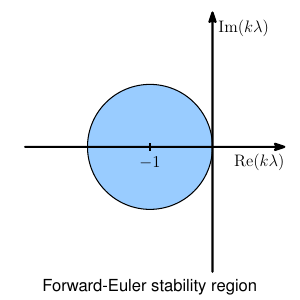
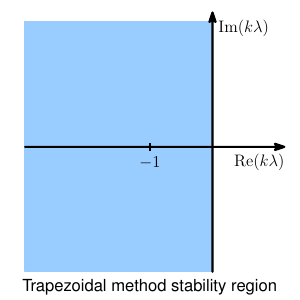
Convergence
For convergence, \(k\) and \(h\) must in general approach zero at appropriate rates, for example \(k\rightarrow 0\) and \(k/h^2 \le 1/2\)
Write the methods as \[\begin{aligned} U^{n+1} = B(k) U^n + b^n(k) \ \ (*) \end{aligned}\] where, e.g., \(B(k) = I+kA\) for forward Euler and \(B(k) = \left( I-\frac{k}{2} A \right)^{-1} \left( I+\frac{k}{2} A \right)\) for Crank-Nicolson
A linear method of the form (*) is Lax-Richtmyer stable if,
for each time \(T\), these is a
constant \(C_T>0\) such that \[\begin{aligned}
\| B(k)^n \| \le C_T
\end{aligned}\]
for all \(k>0\) and integers \(n\) for which \(kn\le T\).
A consistent linear method of the form (*) is convergent if and only if it is Lax-Richtmyer stable.
Lax Equivalence Theorem
Proof. Consider the numerical scheme applied to the
numerical solution \(U\) and the exact
solution \(u(x,t)\): \[\begin{aligned}
U^{n+1} &= BU^n + b^n \\
u^{n+1} &= Bu^n + b^n + k\tau^n
\end{aligned}\]
Subtract to get difference equation for the error \(E^n = U^n - u^n\): \[\begin{aligned}
E^{n+1} = BE^n - k\tau^n, \quad\text{or}\quad
E^N = B^NE^0 - k\sum_{n=1}^N B^{N-n}\tau^{n-1}
\end{aligned}\]
Bound the norm, use Lax-Richtmyer stability and \(Nk\le T\): \[\begin{aligned}
\|E^N\| &\le \|B^N\| \|E^0\| + k
\sum_{n=1}^N \|B^{N-n}\| \|\tau^{n-1}\| \\
& \le C_T \| E^0 \| + T C_T \max_{1\le n\le N} \|\tau^{n-1} \|
\rightarrow 0
\text{ as } k\rightarrow 0
\end{aligned}\]
provided \(\|\tau\|\rightarrow 0\) and
that the initial data \(\|E^0\|\rightarrow
0\). ◻
Convergence
For the FTCS method, \(B(k) = I+kA\) is symmetric, so \(\|B(k)\|_2 = \rho(B) \le 1\) if \(k\le h^2/2\). Therefore, it is Lax-Richtmyer stable and convergent, under this restriction.
For the Crank-Nicolson method, \(B(k) = \left( I-\frac{k}{2} A \right)^{-1} \left( I+\frac{k}{2} A \right)\) is symmetric with eigenvalues \((1+k\lambda_p/2)/(1-k\lambda_p/2)\). Therefore, \(\|B(k)\|_2=\rho(B)<1\) for any \(k>0\) and the method is Lax-Richtmyer stable and convergent.
\(\|B(k)\|\le 1\) is called strong stability, but Lax-Richtmyer stability is also obtained if \(\|B(k)\|\le 1+\alpha k\) for some constant \(\alpha\), since then \[\begin{aligned} \|B(k)^n\| \le (1+\alpha k)^n \le e^{\alpha T} \end{aligned}\]
Von Neumann Analysis
Consider the Cachy problem, on all space and no boundaries (\(-\infty<x<\infty\) in 1D)
The grid function \(W_j = e^{ijh\xi}\), constant \(\xi\), is an eigenfunction of any translation-invariant finite difference operator
Consider the centered difference \(D_0V_j = \frac{1}{2h} (V_{j+1} - V_{j-1})\): \[\begin{aligned} D_0W_j &= \frac{1}{2h} \left( e^{i(j+1) h \xi} - e^{i(j-1) h \xi} \right) = \frac{1}{2h} \left( e^{i h \xi} - e^{- i h \xi} \right) e^{ijh\xi} \\ &= \frac{i}{h} \sin(h\xi) e^{ijh\xi} = \frac{i}{h}\sin(h\xi) W_j, \end{aligned}\] that is, \(W\) is an eigenfunction with eigenvalue \(\frac{i}{h}\sin(h\xi)\)
Note that this agrees to first order with the eigenvalue \(i\xi\) of the operator \(\partial_x\)
Von Neumann Analysis
Consider a function \(V_j\) on the grid \(x_j = jh\), with finite 2-norm \[\begin{aligned} \|V\|_2 = \left( h \sum_{j=-\infty}^{\infty} |V_j|^2 \right) ^{1/2} \end{aligned}\]
Express \(V_j\) as linear combination of \(e^{ijh\xi}\) for \(|\xi|\le \pi/h\): \[\begin{aligned} \hspace{-8mm} V_j = \frac{1}{\sqrt{2\pi}} \int_{-\pi/h}^{\pi/h} \hat{V}(\xi) e^{ijh\xi}\,d\xi,\quad \text{where } \hat{V}(\xi) = \frac{h}{\sqrt{2\pi}} \sum_{j=-\infty}^{\infty} V_j e^{-ijh\xi} \end{aligned}\]
Parseval’s relation: \(\|\hat{V}\|_2 = \|V\|_2\) in the norms \[\begin{aligned} \|V\|_2 = \left( h \sum_{j=-\infty}^{\infty} |V_j|^2 \right) ^{1/2},\quad \|\hat{V}\|_2 = \left( \int_{-\pi/h}^{\pi/h} |\hat{V}(\xi)|^2 d\xi \right) ^{1/2} \end{aligned}\]
Von Neumann Analysis
Using Parseval’s relation, we can show Lax-Richtmyer stability \[\begin{aligned} \|U^{n+1}\|_2 \le (1+\alpha k)\|U^n\|_2 \end{aligned}\] in the Fourier transform of \(U^n\): \[\begin{aligned} \|\hat{U}^{n+1}\|_2 \le (1+\alpha k)\|\hat{U}^n\|_2 \end{aligned}\]
This decouples each \(\hat{U}^n(\xi)\) from all other wave numbers: \[\begin{aligned} \hat{U}^{n+1}(\xi) = g(\xi) \hat{U}^n (\xi) \end{aligned}\] with amplification factor \(g(\xi)\).
If \(|g(\xi)|\le 1+\alpha k\), then \[\begin{aligned} \hspace{-5mm} |\hat{U}^{n+1}(\xi)| \le (1+\alpha k)|\hat{U}^n(\xi)|\quad\text{and}\quad \|\hat{U}^{n+1}\|_2 \le (1+\alpha k)\|\hat{U}^n\|_2 \end{aligned}\]
Von Neumann Analysis
For the FTCS method, \[\begin{aligned}
U_i^{n+1} = U_i^n + \frac{k}{h^2}
\left( U_{i-1}^n - 2U_i^n + U_{i+1}^n \right)
\end{aligned}\]
we get the amplification factor \[\begin{aligned}
g(\xi) = 1 + 2\frac{k}{h^2} (\cos(\xi h) -1)
\end{aligned}\]
and \(|g(\xi)|\le 1\) if \(k\le h^2/2\)
For the Crank Nicolson method, \[\begin{aligned}
\hspace{-1mm}
-rU_{i-1}^{n+1} + (1+2r) U_i^{n+1} -rU_{i+1}^{n+1} =
rU_{i-1}^n + (1-2r) U_i^n +rU_{i+1}^n
\end{aligned}\]
we get the amplification factor \[\begin{aligned}
g(\xi) = \frac{1+\frac12 z}{1-\frac12 z}\quad\text{where}\quad
z = \frac{2k}{h^2} (\cos(\xi h) - 1)
\end{aligned}\]
and \(|g(\xi)|\le 1\) for any \(k,h\)
Multidimensional Problems
Consider the heat equation in two space dimensions: \[\begin{aligned} u_t = u_{xx} + u_{yy} \end{aligned}\] with initial conditions \(u(x,y,0)=\eta(x,y)\) and boundary conditions on the boundary of the domain \(\Omega\).
Use e.g. the 5-point discrete Laplacian: \[\begin{aligned} \nabla_h^2 U_{ij} = \frac{1}{h^2} (U_{i-1,j} + U_{i+1,j} +U_{i,j-1} + U_{i,j+1} - 4U_{ij}) \end{aligned}\]
Use e.g. the trapezoidal method in time: \[\begin{aligned} U_{ij}^{n+1} = U_{ij}^n +\frac{k}{2}\left[ \nabla_h^2 U_{ij}^n + \nabla_h^2 U_{ij}^{n+1} \right] \end{aligned}\] or \[\begin{aligned} \left(I-\frac{k}{2}\nabla_h^2\right)U_{ij}^{n+1} = \left(I+\frac{k}{2}\nabla_h^2\right)U_{ij}^{n} \end{aligned}\]
Linear system involving \(A=I-k\nabla_h^2/2\), not tridiagonal
But condition number \(=O(k/h^2)\), \(\Longrightarrow\) fast iterative solvers
Locally One-Dimensional and Alternating Directions
Split timestep and decouple \(u_{xx}\) and \(u_{yy}\): \[\begin{aligned} U_{ij}^* &= U_{ij}^n + \frac{k}{2} (D_x^2 U_{ij}^n + D_x^2 U_{ij}^*) \\ U_{ij}^{n+1} &= U_{ij}^* + \frac{k}{2} (D_y^2 U_{ij}^* + D_x^2 U_{ij}^{n+1}) \end{aligned}\] or, as in the alternating direction implicit (ADI) method, \[\begin{aligned} U_{ij}^* &= U_{ij}^n + \frac{k}{2} (D_y^2 U_{ij}^n + D_x^2 U_{ij}^*) \\ U_{ij}^{n+1} &= U_{ij}^* + \frac{k}{2} (D_x^2 U_{ij}^* + D_y^2 U_{ij}^{n+1}) \end{aligned}\]
Implicit scheme with only tridiagonal systems
Remains second order accurate
Finite Difference Methods for Hyperbolic Problems
Advection
The scalar advection equation, with constant velocity \(a\): \[\begin{aligned} u_t + au_x = 0 \end{aligned}\]
Cauchy problem needs initial data \(u(x,0)=\eta(x)\), and the exact solution is \[\begin{aligned} u(x,t) = \eta(x-at) \end{aligned}\]
FTCS scheme: \[\begin{aligned} \frac{U_j^{n+1} - U_j^n}{k} = -\frac{a}{2h}\left(U_{j+1}^n - U_{j-1}^n \right) \end{aligned}\] or \[\begin{aligned} U_j^{n+1} = U_j^n - \frac{ak}{2h}\left(U_{j+1}^n - U_{j-1}^n \right) \end{aligned}\]
Stability problems – more later
The Lax-Friedrichs Method
Replace \(U_j^n\) in FTCS by the average of its neighbors: \[\begin{aligned} U_j^{n+1} = \frac12 \left(U_{j-1}^n + U_{j+1}^n \right) - \frac{ak}{2h}\left(U_{j+1}^n - U_{j-1}^n \right) \end{aligned}\]
Lax-Richtmyer stable if \[\begin{aligned} \left| \frac{ak}{h} \right| \le 1, \end{aligned}\] or \(k=\mathcal{O}(h)\) – not stiff
Method of Lines
With bounded domain, e.g. \(0\le x\le 1\), if \(a>0\) we need an inflow boundary condition at \(x=0\): \[\begin{aligned} u(0,t) = g_0(t) \end{aligned}\] and \(x=1\) is an outflow boundary
Opposite if \(a<0\)
Need one-sided differences – more later
Periodic Boundary Conditions
For analysis, impose the periodic boundary conditions \[\begin{aligned} u(0,t) = u(1,t),\qquad \text{for }t\ge 0 \end{aligned}\]
Equivalent to Cauchy problem with periodic initial data
Introduce one boundary value as an unknown, e.g. \(U_{m+1}(t)\): \[\begin{aligned} U(t) = ( U_1(t), U_2(t), \ldots, U_{m+1}(t) )^T \end{aligned}\]
Use periodicity for first and last equations: \[\begin{aligned} U'_1(t) &= -\frac{a}{2h}(U_2(t) - U_{m+1}(t)) \\ U'_{m+1}(t) &= -\frac{a}{2h}(U_1(t) - U_m(t)) \end{aligned}\]
Periodic Boundary Conditions
Leads to Method of Lines formulation \(U'(t) = AU(t)\), where \[\begin{aligned} A = -\frac{a}{2h} \begin{bmatrix} 0 & 1 & & & & -1 \\ -1 & 0 & 1 & & & \\ & -1 & 0 & 1 & & \\ & & \ddots & \ddots & \ddots & \\ & & & -1 & 0 & 1 \\ 1 & & & & -1 & 0 \end{bmatrix} \end{aligned}\]
Skew-symmetric matrix (\(A^T=-A\)) \(\Longrightarrow\) purely imaginary eigenvalues: \[\begin{aligned} \lambda_p = -\frac{ia}{h} \sin (2\pi p h),\qquad p=1,2,\ldots,m+1 \end{aligned}\] with eigenvectors \[\begin{aligned} u_j^p = e^{2\pi i p j h},\qquad\qquad\ \ p,j=1,2,\ldots,m+1 \end{aligned}\]
Forward Euler
Use Forward Euler in time \(\Longrightarrow\) FTCS scheme: \[\begin{aligned} U_j^{n+1} = U_j^n - \frac{ak}{2h}\left(U_{j+1}^n - U_{j-1}^n \right) \end{aligned}\]
Stability region \(\mathcal{S}\): \(|1+k\lambda| \le 1\) \(\Longrightarrow\) imaginary \(k\lambda_p\) will always be outside \(\mathcal{S}\) \(\Longrightarrow\) unstable for fixed \(k/h\)
However, if e.g. \(k=h^2\), we have \[\begin{aligned} |1+k\lambda_p|^2 \le 1 + \left( \frac{ka}{h} \right)^2 \\ = 1+a^2h^2 = 1+a^2k \end{aligned}\] which gives Lax-Richtmyer stability \[\begin{aligned} \hspace{-5mm} \|(I+kA)^n\|_2 \le (1+a^2k)^{n/2} \le e^{a^2T/2} \end{aligned}\]
Not used in practice – too strong restriction on timestep \(k\)

Leapfrog
Consider using the midpoint method in time: \[\begin{aligned} U^{n+1} = U^{n-1} + 2kAU^n \end{aligned}\]
For the centered differences in space, this gives the leapfrog method: \[\begin{aligned} U_j^{n+1} = U_j^{n-1} - \frac{ak}{h} \left(U_{j+1}^n - U_{j-1}^n \right) \end{aligned}\]
Stability region \(\mathcal{S}\): \(i\alpha\) for \(-1<\alpha<1\) \(\Longrightarrow\) stable if \(|ak/h|<1\)
Only marginally stable \(\Longrightarrow\) nondissipative
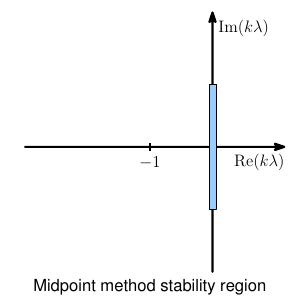
Lax-Friedrichs
Rewrite the average as: \[\begin{aligned} \frac12 \left( U_{j-1}^n + U_{j+1}^n \right) = U_j^n + \frac12 \left( U_{j-1}^n -2U_j^n + U_{j+1}^n \right) \end{aligned}\] to obtain \[\begin{aligned} U_j^{n+1} = U_j^n - \frac{ak}{2h}\left(U_{j+1}^n - U_{j-1}^n \right) +\frac12 \left( U_{j-1}^n - 2U_j^n + U_{j+1}^n \right) \end{aligned}\] or \[\begin{aligned} \frac{U_j^{n+1} - U_j^n}{k} + a \left( \frac{U_{j+1}^n - U_{j-1}^n}{2h} \right) = \frac{h^2}{2k} \left( \frac{U_{j-1}^n - 2U_j^n + U_{j+1}^n}{h^2} \right) \end{aligned}\]
Like a discretization of the advection-diffusion equation \[\begin{aligned} u_t + au_x = \epsilon u_{xx} \end{aligned}\] where \(\epsilon = h^2/(2k)\).
Lax-Friedrichs
The Lax-Friedrichs method can then be written as \(U'(t) = A_\epsilon U(t)\) with \[\begin{aligned} A_\epsilon = -\frac{a}{2h} & \begin{bmatrix} 0 & 1 & & & & -1 \\ -1 & 0 & 1 & & & \\ & -1 & 0 & 1 & & \\ & & \ddots & \ddots & \ddots & \\ & & & -1 & 0 & 1 \\ 1 & & & & -1 & 0 \end{bmatrix} \\ +\frac{\epsilon}{h^2} & \begin{bmatrix} -2 & 1 & & & & 1 \\ 1 & -2 & 1 & & & \\ & 1 & -2 & 1 & & \\ & & \ddots & \ddots & \ddots & \\ & & & 1 & -2 & 1 \\ 1 & & & & 1 & -2 \end{bmatrix} \end{aligned}\] where \(\epsilon=h^2/(2k)\)
Lax-Friedrichs
The eigenvalues of \(A_\epsilon\) are shifted from the imaginary axis into the left half-plane: \[\begin{aligned} \mu_p = -\frac{ia}{h}\sin(2\pi p h) - \frac{2\epsilon}{h^2}(1-\cos(2\pi p h )) \end{aligned}\]
The values \(k\mu_p\) lie on an ellipse centered at \(-2k\epsilon/h^2\), with semi-axes \(2k\epsilon/h^2\), \(ak/h\)
For Lax-Friedrichs, \(\epsilon = h^2/(2k)\) and \(-2k\epsilon/h^2 = -1\) \(\Longrightarrow\) stable if \(|ak/h|\le 1\)
The Lax-Wendroff Method
Use Taylor series method for higher order accuracy in time
For \(U'(t) = AU(t)\), we have \(U''=AU'=A^2U\) and the second-order Taylor method \[\begin{aligned} U^{n+1} = U^n + kAU^n + \frac12 k^2 A^2 U^n \end{aligned}\]
Note that \[\begin{aligned} (A^2U)_j = \frac{a^2}{4h^2} \left( U_{j-2} - 2U_j + U_{j+2} \right) \end{aligned}\] so the method can be written \[\begin{aligned} U_j^{n+1} = U_j^n - \frac{ak}{2h} \left(U_{j+1}^n - U_{j-1}^n \right) + \frac{a^2k^2}{8h^2}\left( U_{j-2}^n - 2U_j^n + U_{j+2}^n \right) \end{aligned}\]
Replace last term by 3-point discretization of \(a^2k^2u_{xx}/2\) \(\Longrightarrow\) the Lax-Wendroff method: \[\begin{aligned} U_j^{n+1} = U_j^n - \frac{ak}{2h} \left(U_{j+1}^n - U_{j-1}^n \right) + \frac{a^2k^2}{2h^2}\left( U_{j-1}^n - 2U_j^n + U_{j+1}^n \right) \end{aligned}\]
Stability analysis
The Lax-Wendroff method is Euler’s method applied to \(U'(t)=A_\epsilon U(t)\), with \(\epsilon=a^2k/2\) \(\Longrightarrow\) eigenvalues \[\begin{aligned} k\mu_p = -i\left( \frac{ak}{h} \right) \sin(p\pi h) + \left( \frac{ak}{h} \right)^2 (\cos(p\pi h) - 1) \end{aligned}\]
On ellipse centered at \(-(ak/h)^2\) with semi-axes \((ak/h)^2\), \(|ak/h|\)
Stable if \(|ak/h|\le 1\)
Upwind methods
Consider one-sided approximations for \(u_x\), e.g. for \(a>0\): \[\begin{aligned} U_j^{n+1} = U_j^n - \frac{ak}{h}(U_j^n - U_{j-1}^n),\text{ stable if } 0\le \frac{ak}{h}\le 1 \end{aligned}\] or, if \(a<0\): \[\begin{aligned} U_j^{n+1} = U_j^n - \frac{ak}{h}(U_{j+1}^n - U_j^n),\text{ stable if } -1\le \frac{ak}{h}\le 0 \end{aligned}\]
Natural with asymmetry for the advection equation, since the solution is translating at speed \(a\)
Stability analysis
The upwind method for \(a>0\) can be written \[\begin{aligned} U_j^{n+1} = U_j^n - \frac{ak}{2h} (U_{j+1}^n - U_{j-1}^n) +\frac{ak}{2h}(U_{j+1}^n - 2U_j^n + U_{j-1}^n) \end{aligned}\]
Again like a discretization of advection-diffusion \(u_t+au_x = \epsilon u_{xx}\), with \(\epsilon=ah/2\) \(\Longrightarrow\) stable if \[\begin{aligned} -2 < -2\epsilon k/h^2<0,\quad\text{or}\quad 0\le \frac{ak}{h} \le 1 \end{aligned}\]
The three methods, Lax-Wendroff, upwind, Lax-Friedrichs, can all be written as advection-diffusion with \[\begin{aligned} \epsilon_{LW} = \frac{a^2k}{2}=\frac{ah\nu}{2},\quad \epsilon_{up} = \frac{ah}{2},\quad \epsilon_{LF} = \frac{h^2}{2k} = \frac{ah}{2\nu} \end{aligned}\] where \(\nu=ak/h\). Stable if \(0<\nu<1\).
The Beam-Warming method
Like upwind, but use second-order one-sided approximations: \[\begin{aligned} U_j^{n+1} = &U_j^n - \frac{ak}{2h}(3U_j^n-4U_{j-1}^n+U_{j-2}^n) \\ & +\frac{a^2k^2}{2h^2}(U_j^n-2U_{j-1}^n+U_{j-2}^n)\quad\text{for } a>0 \end{aligned}\] and \[\begin{aligned} U_j^{n+1} = &U_j^n - \frac{ak}{2h}(-3U_j^n+4U_{j+1}^n-U_{j+2}^n) \\ & +\frac{a^2k^2}{2h^2}(U_j^n-2U_{j+1}^n+U_{j+2}^n)\quad\text{for } a<0 \end{aligned}\]
Stable if \(0\le\nu\le 2\) and \(-2\le\nu\le 0\), respectively
Von Neumann analysis
\[\begin{aligned} g(\xi) = (1-\nu) + \nu e^{-i\xi h} \end{aligned}\] where \(\nu=ak/h\), stable if \(0\le \nu \le 1\)
\[\begin{aligned} g(\xi) = \cos(\xi h) -\nu i \sin(\xi h) &\Longrightarrow |g(\xi)|^2 = \cos^2(\xi h) + \nu^2 \sin^2(\xi h), \end{aligned}\] stable if \(|\nu|\le 1\)
Von Neumann analysis
\[\begin{aligned} g(\xi) = 1-i\nu[2\sin(\xi h/2)\cos(\xi h/2)] - \nu^2[2\sin^2(\xi h/2)] \\ \Longrightarrow |g(\xi)|^2 = 1-4\nu^2(1-\nu^2)\sin^4(\xi h/2) \end{aligned}\] stable if \(|\nu|\le 1\)
\[\begin{aligned} g(\xi)^2 = 1-2\nu i \sin(\xi h) g(\xi), \end{aligned}\] stable if \(|\nu|<1\) (like the midpoint method)
Characteristic tracing and interpolation
Consider the case \(a>0\) and \(ak/h<1\)
Trace characteristic through \(x_j,t_{n+1}\) to time \(t_n\)
Find \(U_j^{n+1}\) by linear interpolation between \(U_{j-1}^n\) and \(U_j^n\): \[\begin{aligned} U_j^{n+1} = U_j^n - \frac{ak}{h} (U_j^n - U_{j-1}^n) \end{aligned}\] \(\Longrightarrow\) first order upwind method
Quadratic interpolating \(U_{j-1}^n\), \(U_j^n\), \(U_{j+1}^n\) \(\Longrightarrow\) Lax-Wendroff
Quadratic interpolating \(U_{j-2}^n\), \(U_{j-1}^n\), \(U_{j}^n\) \(\Longrightarrow\) Beam-Warming
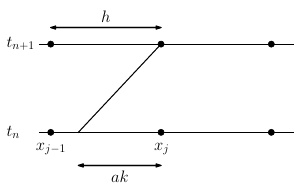
The CFL condition
For the advection equation, \(u(X,T)\) depends only on the initial data \(\eta(X-aT)\)
The domain of dependence is \(\mathcal{D}(X,T) = \{X-aT\}\)
Heat equation \(u_t=u_{xx}\), \(\mathcal{D}(X,T) = (-\infty,\infty)\)
Domain of dependence for 3-point explicit FD method: Each value depends on neighbors at previous timestep
Refining the grid with fixed \(k/h\equiv r\) gives same interval
This region must contain the true \(\mathcal{D}\) for the PDE: \[\begin{aligned} X-T/r\le X-aT \le X+T/r \end{aligned}\] \(\Longrightarrow\) \(|a|\le 1/r\) or \(|ak/h|\le 1\)
The Courant-Friedrichs-Lewy (CFL) condition: Numerical domain of dependence must contain the true \(\mathcal{D}\) as \(k,h\rightarrow 0\)
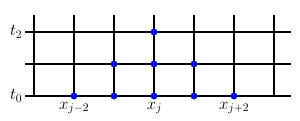
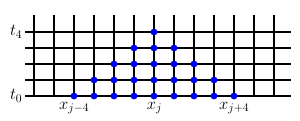
The CFL condition
The centered-difference scheme for the advection equation is unstable for fixed \(k/h\) even if \(|ak/h|\le 1\)
3-point one-sided stencil, CFL condition gives \(0\le ak/h\le 2\) (for left-sided, used when \(a>0\))
\(\mathcal{D}(X,T) = (-\infty,\infty)\) \(\Longrightarrow\) any 3-point explicit method violates CFL condition for fixed \(k/h\)
However, with \(k/h^2\le 1/2\), all of \(\mathbb{R}\) is covered as \(k\rightarrow 0\)
Any implicit scheme satisfies the CFL condition, since the tridiagonal linear system couples all points.
Modified equations
Find a PDE \(v_t=\cdots\) that the numerical approximation \(U_j^n\) satisfies exactly, or at least better than the original PDE
To second order accuracy, the numerical solution satisfies \[\begin{aligned}
v_t + av_x = \frac12 a h \left( 1 - \frac{ak}{h} \right) v_{xx}
\end{aligned}\]
Advection-diffusion equation
To third order accuracy, \[\begin{aligned}
v_t + av_x + \frac16 ah^2\left( 1- \left(\frac{ak}{h}\right)^2 \right)
v_{xxx} = 0
\end{aligned}\]
Dispersive behavior, leading to a phase error. To
fourth order, \[\begin{aligned}
v_t + av_x + \frac16 ah^2\left( 1- \left(\frac{ak}{h}\right)^2 \right)
v_{xxx} = -\epsilon v_{xxxx}
\end{aligned}\]
where \(\epsilon=O(k^3+h^3)\) \(\Longrightarrow\) highest modes damped
Modified equations
To third order, \[\begin{aligned} v_t + av_x = \frac16 a h^2 \left(2-\frac{3ak}{h}+\left(\frac{ak}{h}\right)^2\right) v_{xxx} \end{aligned}\] Dispersive, similar to Lax-Wendroff
Modified equation \[\begin{aligned} v_t + av_x + \frac16 ah^2\left(1-\left(\frac{ak}{h}\right)^2\right) v_{xxx} = \epsilon v_{xxxxx} + \cdots \end{aligned}\] where \(\epsilon=O(h^4+k^4)\) \(\Longrightarrow\) only odd-order derivatives, nondissipative method
Hyperbolic systems
The methods generalize to first order linear systems of equations of the form \[\begin{aligned} &u_t + Au_x = 0, \\ &u(x,0) = \eta(x), \end{aligned}\]
where \(u : \mathbb{R} \times \mathbb{R} \rightarrow \mathbb{R}^s\) and a constant matrix \(A\in\mathbb{R}^{s\times s}\)Hyperbolic system of conservation laws, with flux function \(f(u)=Au\), if \(A\) diagonalizable with real eigenvalues: \[\begin{aligned} A=R\Lambda R^{-1}\quad\text{or}\quad Ar_p = \lambda_p r_p\text{ for }p=1,2,\ldots,s \end{aligned}\]
Change variables to eigenvectors, \(w=R^{-1}u\), to decouple system into \(s\) independent scalar equations \[\begin{aligned} (w_p)_t + \lambda_p (w_p)_x = 0,\quad p=1,2,\ldots, s \end{aligned}\]
with solution \(w_p(x,t) = w_p(x-\lambda_p t,0)\) and initial condition the \(p\)th component of \(w(x,0)=R^{-1}\eta(x)\).Solution recovered by \(u(x,t) = Rw(x,t)\), or \[\begin{aligned} u(x,t) = \sum_{p=1}^s w_p(x-\lambda_p t, 0)r_p \end{aligned}\]
Numerical methods for hyperbolic systems
Most methods generalize to systems by replacing \(a\) with \(A\)
\[\begin{aligned} U_j^{n+1} = U_j^n - \frac{k}{2h} A(U_{j+1}^n - U_{j-1}^n) + \frac{k^2}{2h^2} A^2 (U_{j-1}^n - 2U_j^n + U_{j+1}^n) \end{aligned}\] Second-order accurate, stable if \(\nu = \max_{1\le p \le s} |\lambda_p k/h| \le 1\)
\[\begin{aligned} U_j^{n+1} &= U_j^n - \frac{k}{h} A(U_j^n - U_{j-1}^n) \\ U_j^{n+1} &= U_j^n - \frac{k}{h} A(U_{j+1}^n - U_{j}^n) \end{aligned}\] Only useful if all eigenvalues of \(A\) have same sign. Instead, decompose into scalar equations and upwind each one separately \(\Longrightarrow\) Godunov’s method
Initial boundary value problems
For a bounded domain, e.g. \(0\le x \le 1\), the advection equation requires an inflow condition \(x(0,t)=g_0(t)\) if \(a>0\)
This gives the solution \[\begin{aligned} u(x,t) = \begin{cases} \eta(x-at) & \text{if }0\le x-at\le 1, \\ g_0(t-x/a) & \text{otherwise}. \end{cases} \end{aligned}\]
First-order upwind works well, but other stencils need special cases at inflow boundary and/or outflow boundary
von Neumann analysis not applicable, but generally gives necessary conditions for convergence
Method of Lines applicable if eigenvalues of discretization matrix are known